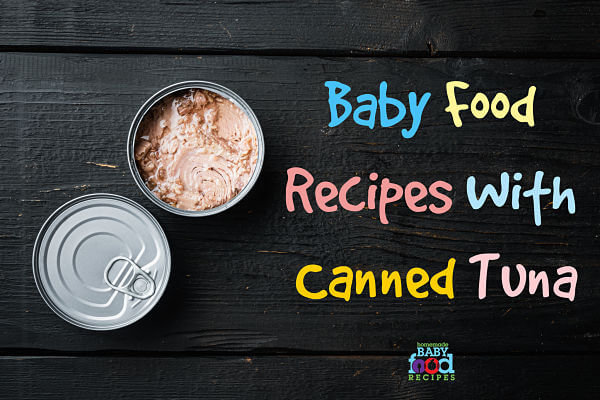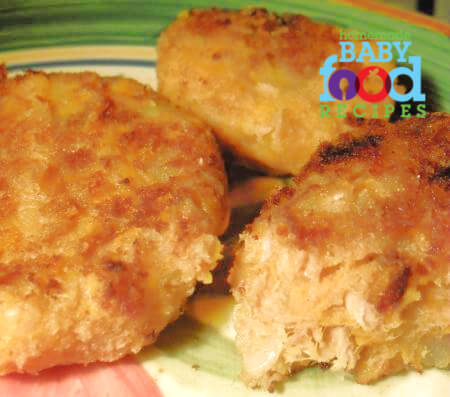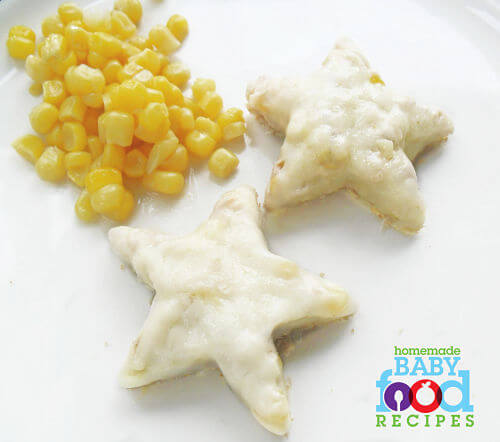Baby Food Recipes with Canned Tuna
On this page we'll share our simple and delicious baby food recipes with canned tuna.
We'll also look at which types of tuna are best for your little one and why experts recommend that your baby only eats a small amount each week.
The Benefits of Canned Tuna for Baby
Whilst fresh tuna is the best source of nutrients for your baby, it's not always easy to get hold of - and it can be very expensive.
Canned tuna - often referred to as tuna fish in the US - is a great alternative. It's convenient, widely available and relatively inexpensive! It's also lower in contaminants like mercury (more on that below).
Tuna is a good source of
When to Introduce Tuna to Your Baby
You can start including tuna in your baby's meals from around 7 months of age - indeed, studies have shown that offering fish to your baby before 9 months of age can help protect against eczema.
And separate research - carried out in Sweden - showed that babies are less likely to suffer from 'pre-school wheeze' if they start enjoying fish before 9 months of age.
That being said, it's a good idea to check with your doctor before introducing any fish to your baby, in case there are any reasons it may not be suitable for your little one at this stage.
Which Type is Best for Baby?
The two main varieties of canned tuna are chunk light and solid or chunk white.
In America, only albacore can legally be sold as white meat tuna. In other countries, cans of white meat tuna may also contain yellowfin.
Tuna usually comes packed in either:
- Water - this is the best choice for your baby*
- Oil
- Sauce - We don't recommend offering this to your baby, as the sauce is very likely to contain extra salt and other ingredients that may not be suitable for him
Sometimes, you can buy tuna pre-drained (although you pay quite dearly for the convenience!)
*Why is water-packed tuna better for your baby?
When tuna is packed in oil, the oil mixes with the natural fat in the tuna. When you drain the tuna, you are also draining away the tuna's natural fat, which is the source of the omega 3 fatty acids.
Oil and water, however, don't mix. So when you drain tuna packed in water, you can be confident that those all-important nutrients are still in the fish when you serve it!
Whilst white meat tuna (albacore) is higher in omega 3 than skipjack/light tuna, it's not ideal for your baby as it contains higher levels of mercury.
canned tuna is cooked and ready for your baby to eat
Fresh tuna goes through quite an extensive cooking process before it hits the store shelves in cans!
The fish is pre-cooked for anywhere between 45 minutes and 3 hours before it is cleaned and filleted, then it is canned and sealed. The sealed can is then heated for between 2 and 4 hours.
The extensive cooking times are needed to ensure that any bacteria are destroyed, although the 'double cooking' method is used because it helps the manufacturers to de-bone the fish more quickly.
omega 3 levels can vary by brand
Specialty tuna products tend to be cooked only once, retaining more of their natural fats, and they are often packed in their own oils.
They may be more expensive, but the increased health benefits may make them a better choice for your baby.
Canned Tuna and Mercury
Whilst fish is a healthy food, something to consider is how much mercury it contains.
Mercury is harmful and has been linked to serious medical issues, so it's important to minimize your baby's exposure to mercury as much as possible.
As a general rule, the larger the fish, the more mercury it is likely to contain. This means that it is always better to choose smaller fish to use in your baby food recipes.
When it comes to tuna, this means that light or skipjack tuna are the safest options. Fortunately, these are the more economical options, too!
Indeed, the FDA lists canned light tuna as one of the fish LOWEST in mercury and one of the best choices for young children
You should avoid albacore, ahi, bigeye and yellowfin tuna in your baby food recipes. These are larger fish and contain higher levels of mercury.
how much tuna is safe for your baby to eat?
The non-profit Environmental Defense Fund says that children under 6 years of age can eat up to 3 x 3 oz portions of canned light tuna per month.
This advice is more or less in line with that given by the FDA.
The FDA guidelines say that pregnant women may eat up to 12 oz of low-mercury fish per week and that parents should follow these same recommendations when feeding fish and shellfish to (their) young child, but serve smaller portions.
what to look for when buying canned tuna
When buying cans of tuna, make sure they don't have any dents, cracks, discolouration or bulges.
Many varieties of tuna contain added salt - try to choose reduced sodium or unsalted varieties if possible.
If these are unavailable, try draining the tuna then rinsing it 2 or 3 times with cool water to remove excess salt. This is reported to reduce the sodium content by 80%.
storing tuna
Keep unopened cans of tuna in a cool, dry place and use by the date shown on the can.
Once opened, you should store any unused tuna in the fridge in an airtight container and use it within 2 days. Alternatively, you can freeze it for up to 3 months.
Tuna Baby Food Ideas
There are a few simple ways to include tuna in your baby's daily menu - with no recipe required!
- Mix tuna with well-mashed avocado and use it to top a jacket potato
- Use the avocado/tuna combination as a toast topper, or inside a sandwich
- Mix tuna with natural yogurt to make a simple dip and serve with toast fingers or pieces of pita
- Add tuna to mac & cheese
- Mix tuna with cooked broccoli and mashed potato and mash together. Thin with a little milk if needed.
- Use tuna instead of the main protein in other recipes. It's already cooked, so it's a real time-saver, but just remember to adjust the cooking time accordingly
A yummy finger food recipe with tuna…
Tuna Baby Food Recipes
fruity tuna treat (7 months+)
1/2 ripe avocado
1 tablespoon tuna
3 grapes, peeled and finely chopped
- Mash or puree the avocado until smooth.
- Mix the avocado with the tuna and grapes. Mash or puree as necessary.
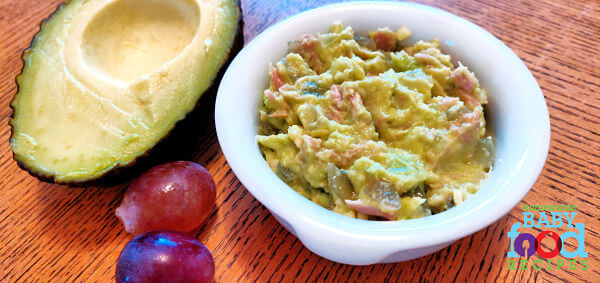
tuna sandwich spread (7 months+)
2 tablespoons natural yogurt
1 tablespoon grated pear
1 tablespoon tuna
- Simply mix all the ingredients together and serve as a sandwich filling or dip. This also works well with finely chopped grapes instead of pear.
tuna and rice dinner (7 months+)
2 tablespoons cooked brown rice
1 tablespoon frozen peas, thawed
1 tablespoon tuna
1/4 cup low sodium or homemade vegetable stock
- Place all the ingredients into a small saucepan and heat gently for around 5 minutes, stirring.
- Either serve just as it is, or transfer the mixture to a blender and process, adding extra stock until you achieve a smooth consistency.
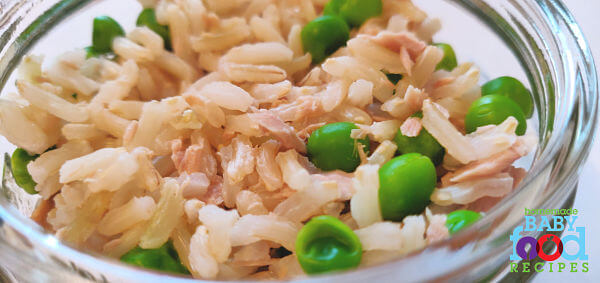
fruity tuna and hummus (7 months+)
2 tablespoons hummus
1/2 avocado, mashed or pureed until smooth
1/2 sweet apple, peeled, cored and chopped
1 tablespoon tuna
1/4 cup apple juice
little pinch of curry powder (optional)
- Place the apple pieces and juice into a small saucepan and cook for a few minutes, until the apple is soft.
- Mix the cooked apple with the hummus, avocado, tuna and curry powder (if using), adding a little extra apple juice to achieve the desired consistency.
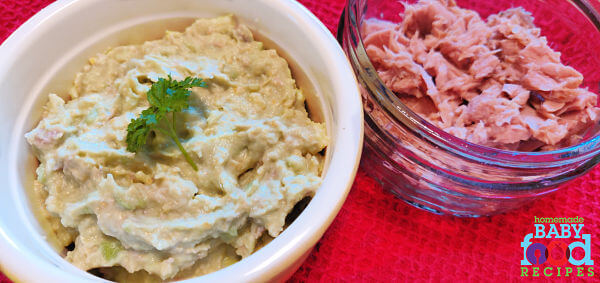
tuna melt (a fab finger food)
1 English muffin
teaspoon olive oil
1 tablespoon tuna
2 tablespoons grated cheddar cheese
- Cut the muffin in half and toast both sides.
- Brush one side with the olive oil (and if your baby likes garlic, rub it with a peeled clove too).
- Put the tuna on top, cover it with the grated cheese and place back under the broiler/grill.
- Cook until the cheese has melted, then cool and serve.
Tip: This recipe tastes amazing with a little chopped pineapple mixed in with the tuna!
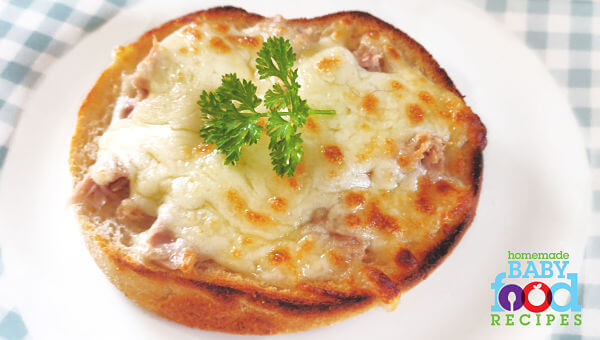
baked tuna pasta (7 months+)
1/2 pack penne pasta (around 8 oz)
1 1/2 tbsp unsalted butter
1 small onion, finely chopped
1 tbsp all-purpose (plain) flour
1 1/4 cups milk (use cow's milk, breast milk or formula)
1 cup grated Cheddar cheese
1 x 5 oz can of tuna
1/2 cup canned sweetcorn
- Heat the oven to 350 deg F.
- Cook the penne according to the instructions on the packaging.
- Whilst the pasta is cooking, melt the butter and cook the onion gently until soft (around 6 mins).
- Gradually stir in the flour and increase the heat to medium.
- Cook for 2 mins, then slowly add the milk, stirring constantly.
- Continue to cook, stirring, as the sauce thickens.
- Remove from the heat and stir in 3/4 of the grated cheese. Continue to stir until the cheese has melted.
- Drain the pasta and place in an oven-proof dish. Add the tuna and sweetcorn to the cheese sauce, mix well, then pour the sauce over the pasta.
- Top with the grated cheese, then place in the oven. Cook for around 20 minutes until the mixture is bubbling and the cheese on the top is melted and golden.
- Chop pasta to size (if necessary) and serve.
TIP: You can substitute the sweetcorn for any cooked veggie your baby enjoys. Try adding chopped herbs to the cheese sauce for a richer flavour!
tuna & Veggie pancakes (soft and easy to eat)
1 small zucchini, grated
half a 5 oz can of tuna, thoroughly drained
1 egg
1 tablespoon all-purpose (plain) flour
olive oil
- Squeeze the grated zucchini to remove as much moisture as you can (we wrap it in a piece of strong kitchen towel). Both the zucchini and the tuna need to be as dry as possible to help the pancake mixture stay together.
- Whisk together the egg and flour, then stir in the tuna and zucchini and mix thoroughly.
- Heat a little olive oil in a frying pan and spoon the mixture into the pan to create 4 pancakes.
- Fry for a minute or two on each side, until golden.
Tip: These are great to make in bulk then freeze to use in future.
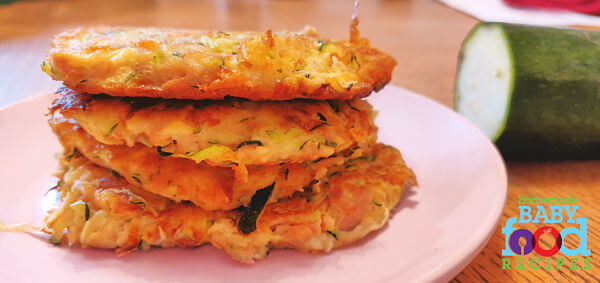
another tempting tuna treat…
Sources:
Healthline - Should You Avoid Fish Because of Mercury?

